I think the best way to describe pavlova, beloved dessert of Australia and New Zealand, is part cake, part cloud – a thick layer of whipped cream over a round bed of meringue, crackly sweet on the outside, soft and marshmallowy inside, with fresh fruit scattered over it all. It feels like cake, but it has no flour at all.
Spectacular to present and ethereally delightful to eat, pavlova is a brilliant trick of a dessert for home cooks – easy to make and no problem to make ahead. Don’t let the word meringue put you off – this one is painlessly simple, and the beauty of pavlova is that even a messy meringue gets beautifully blanketed with whipped cream. No pressure for perfection here.
Gluten-free – wheat-free, even – pavlova is an especially great find for celiac patients, or Passover bakers. Through the magic of physics, egg whites and sugar are whipped up into a round base, which cuts and serves like a cake, but without the butter and flour of a regular cake.
You can even bake your meringue a day or two ahead and then, when you’re ready, layer it in a flash with whipped cream and anything else you’d like on top. It works just as well as a cool summertime dessert or a lighter finish to a heavy winter’s meal. Everyone loves it.
My friend Nicole has been telling me for years about pavlova – it’s her favorite dessert and birthday cake – but I never got around to trying it until this month, when I had egg whites left over from my husband’s birthday chocolate pie. It was devoured in an instant, and I’ve made it a couple times since to make sure I have the most straightforward and bulletproof recipe for my future pavlovas and yours.
Fruit is the traditional topping, sometimes together with a sauce or lemon curd. You could feature berries or stone fruit in the summer; citrus or pomegranate in the winter; mango or passionfruit if you’re feeling tropical.
Pavlovas tend to run extremely sweet – mine has 25-40% less sugar than most, and it’s still plenty sweet. I serve mine with unsweetened whipped cream, and even the kids don’t pick up on it, because the meringue is sweet enough for both.
There’s not much to a pavlova – egg whites and sugar, a drop of vanilla for flavor. Cornstarch and lemon juice (or white vinegar) for stability. Whipped cream and fruit (or anything else you’d like) on top.
You know that it’s best to crack your egg on a flat surface, right? Just give it a quick rap on the countertop until you hear the shell crack. You’re less likely to have pieces of shell break off than if you crack it on an edge (eg bowl rim or counter’s edge).
Cradle the yolk in a half-shell while you let the white slip down. If the weight of the egg white doesn’t break it off from the yolk, use the other half-shell to cut the egg white gently off the shell’s edge. Take care not to puncture the yolk – even a dribble of yellow will keep your meringue from setting up correctly.
Separate each egg white into a little bowl first. That way you don’t ruin your mixing bowl of egg whites with one botched separation.
Egg whites do better with a slow start, so mix on low for a minute first.
Then speed up to medium until the egg whites hold a soft peak when you lift the mixer.
Vanilla extract colors the meringue a little pink; leave it out if you prefer. Mix in a bit of cornstarch with granulated sugar, then stream it in slowly, about a tablespoon at a time to give it time to dissolve, as you continue mixing.
Keep beating until the egg whites hold a firm peak when you lift the mixer. It’s better to err on the side of underbeating than overbeating (the egg whites will get grainy and liquid will separate out again), so stop as soon as a peak holds well enough.
The finished egg whites should be thick and glossy.
Pour the mixture out onto a parchment-lined baking sheet (you can also use aluminum foil in a pinch), and smooth it out to make a thick round, with a slight dip in the top to hold the whipped cream. Many recipes will have you measure a circle on the parchment, but I find it’s not necessary to be precise on shape or size.
Let the meringue cool gradually in the oven after baking. It may crack as it cools, but it’ll all be hidden by whipped cream anyway.
Assemble the pavlova just before serving. If don’t plan to finish your pavlova all at once, you can make the meringue into smaller rounds and assemble them as needed. It stores well in an airtight container for a couple of days.
In California it’s prime grape season, and strawberries are still hanging in. But if you wanted to use toasted nuts and shaved chocolate, that would be amazing too.
I overdid the whipped cream on this one. But no one seemed to mind.
Pavlova
A year-round favorite in Australia and New Zealand, pavlova is part cake, part cloud – a giant meringue layered with whipped cream and fresh fruit. It’s equally good as a cool summer dessert or a light finish to a heavy winter’s meal. Gluten free – wheat free, even – it’s also the perfect cake for celiac patients or Passover bakers. Don’t be put off by the word meringue – this is easy to make, easy to make ahead, and spectacular to serve.
Ingredients
- 4 egg whites, at room temperature (see notes for egg tips)
- 1 teaspoon white vinegar (or lemon juice)
- Pinch salt
- 3/4 cup granulated (or superfine) sugar
- 2 teaspoons cornstarch
- 1/2 teaspoon vanilla
- 1 cup heavy (whipping) cream
- 4 cups fresh fruit (berries, plums, peaches in warmer months; citrus, kiwi or pomegranate in cooler months; mango or passionfruit for a tropical touch)
Preparation
- Preheat oven to 300 degrees F (150 degrees C). Line a baking sheet with parchment paper (aluminum foil will also work, but it sticks to the meringue more than parchment does).
- In a small bowl, mix cornstarch into sugar. In a clean, dry mixing bowl (stainless steel or glass – not plastic), add egg whites, vinegar and pinch of salt. If egg whites are still cold, leave them out a few minutes before you begin. Use an electric mixer, starting at low speed for a minute then increasing to medium, to beat the egg whites until the foam forms soft peaks when you lift the mixer.
- Add vanilla to egg whites. Then add sugar mixture slowly, about 1 tablespoon at a time, while continuing to beat the egg whites on high until glossy and thick. When you lift the mixer, the egg white on the beater should hold a peak that stays upright instead of drooping over. Stop to check frequently, as you don’t want to overbeat (the egg whites will get grainy and liquid will separate out again).
- Pour the egg white mixture onto the parchment paper, using a spatula to spread it gently into a circle 8-9 inches in diameter, with the top slightly depressed toward the center of the round.
- Bake the meringue for 1 hour (should be dry to the touch when done; try not to open the oven door during cooking). Turn off the oven and leave the pavlova in the oven to cool gradually for a couple of hours or overnight (gradual cooling reduces cracking of the meringue). If you are in a hurry you can prop the door ajar with a wooden spoon to bring the temperature down more quickly.
- Before serving, whip the cream until it holds firm peaks. You don’t need to sweeten the whipped cream – the meringue is sweet enough for both. But if you prefer it a little sweet, add a tablespoon of granulated or powdered sugar during beating as the cream starts to foam.
- Carefully remove the meringue from the parchment paper to a serving platter. Spread whipped cream over, then top with fresh fruit.
Serves 8.
Notes
- Very fresh eggs are hard to foam; use older eggs for better results.
- Cold eggs are easier to separate, so best to separate the whites from the yolks and then let them come to room temperature.
- Separate eggs one at a time into two small bowls, one for a single egg white and one for accumulated egg yolks. After each successful separation, pour the egg white into the mixing bowl. If you botch one separation, just put that egg white and yolk aside for another use and start again with a new egg. That way you don’t ruin a whole batch of egg whites with one drop of yolk.
- Use an eggshell to fish out any broken pieces of eggshell in your egg whites.
- Do not use vinegar if mixing egg whites in a copper bowl (the acid reacts with the copper).
- Meringues are very sensitive to moisture, so if the weather is wet or humid you may want to save pavlova making for a drier day.
- The meringue base can be made ahead of time and stored in an airtight container, at room temperature, for a couple of days. If you live in a humid climate, store the meringue in the freezer.
- You can also make several smaller meringues instead of one large one. This is especially useful if you don’t plan on eating the whole pavlova in one go – the meringues will keep well in an airtight container, and you can assemble them fresh with whipped cream and fruit as needed.
- Larger version (6 eggs; 12 servings): 6 egg whites, 1 1/2 t vinegar, 1 cup sugar mixed with 1 tablespoon cornstarch, 3/4 teaspoon vanilla, 1 1/2 cups heavy cream, 6 cups of fruit. Make a larger circle (10 inches) and bake for 75 minutes.
- If your meringue is a fallen mess, or if you have leftover, there’s a lovely dessert for you called Eton mess: break the meringue into whipped cream, mix it together and layer it in cups with fruit. Can’t lose.
Here’s the link to a printable version.

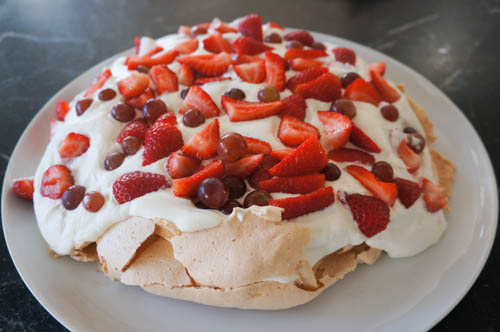
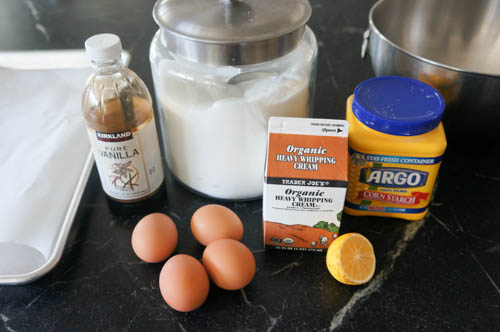
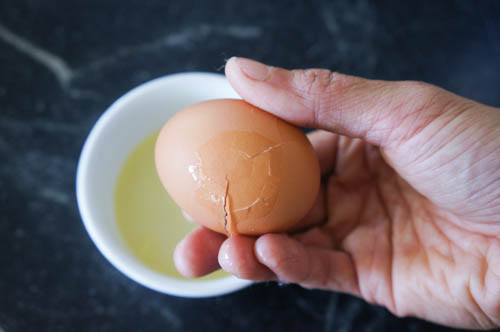
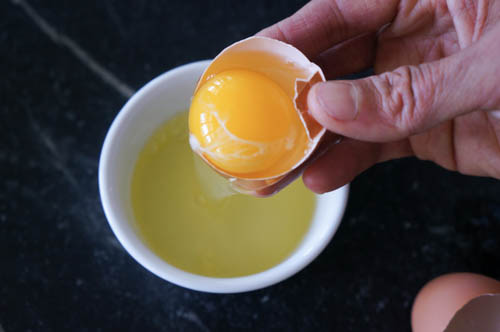

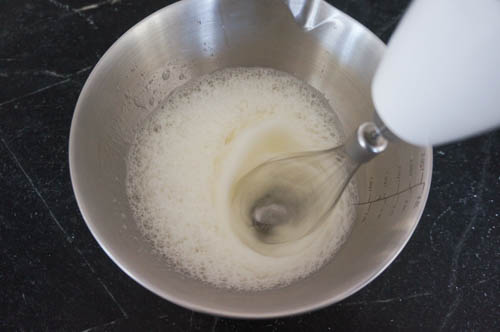
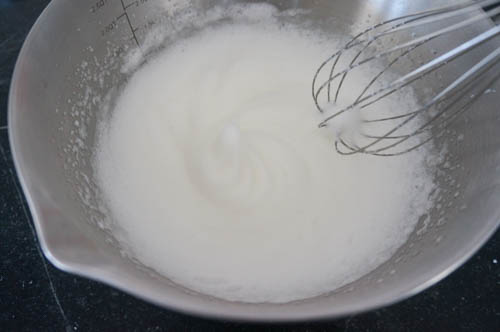
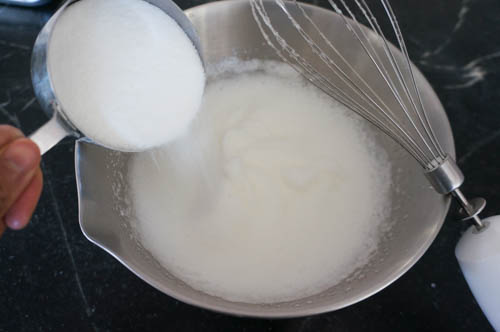
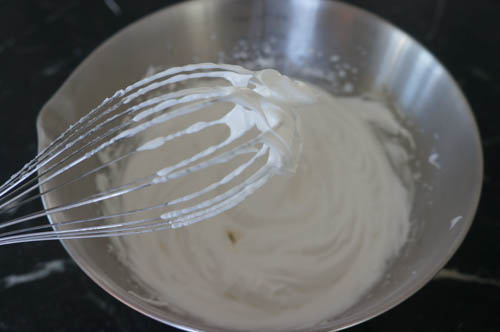


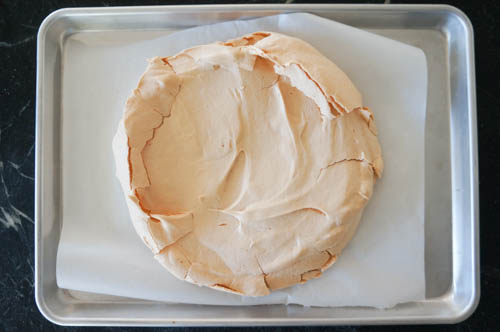
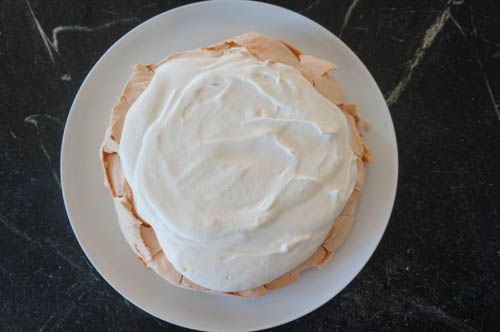
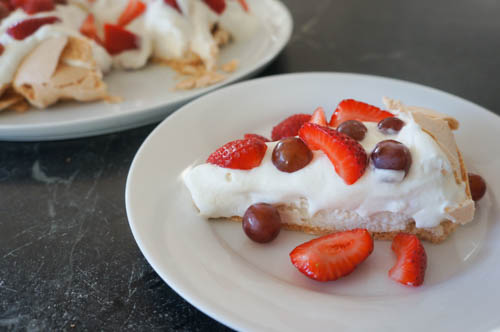


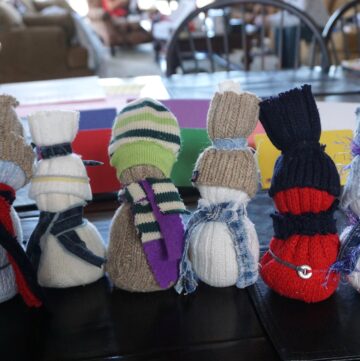

Love Pavlovas!!! Have you tried a chocolate version? Absolutely delicious!! And you can make pot de creme with the leftover yolks!! Super excited to try yours with reduced sugar. I am not fond of overly sweetened desserts. Thanks for a great recipe!
Wow, like the sound of a chocolate version.